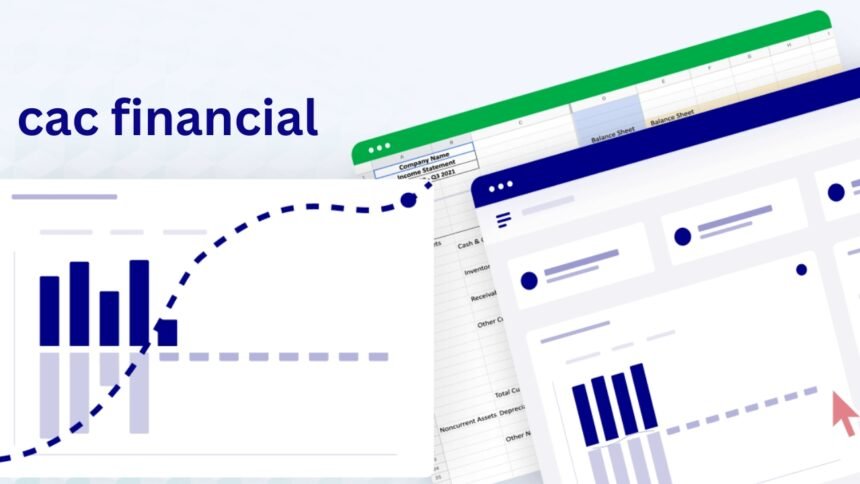In today’s competitive business environment, understanding financial metrics is essential to ensuring sustainable growth. One such metric that has garnered attention over the years is CAC financial, also known as Customer Acquisition Cost (CAC). This metric plays a crucial role in measuring the efficiency and profitability of a business’s marketing and sales efforts. For companies looking to optimize their operations, reducing CAC while improving customer lifetime value is key to long-term success.
CAC financial refers to the cost incurred by a company to acquire a new customer. This metric is important as it provides insights into the effectiveness of marketing and sales strategies. If a business’s CAC is too high, it could indicate inefficiencies in its customer acquisition process or reveal that the business is overspending on marketing without seeing a corresponding return. By understanding CAC financial in-depth, companies can fine-tune their strategies to acquire customers more efficiently while maintaining profitability.
Understanding the Components of CAC Financial
The Formula Behind CAC
Customer Acquisition Cost (CAC) is typically calculated by dividing the total expenses spent on acquiring customers—such as marketing, sales, and advertising costs—by the number of customers acquired in a specific period. The formula for CAC is simple:
CAC = Total Sales and Marketing Expenses / Number of Customers Acquired
This simple equation can yield valuable insights into how much money a business needs to spend to secure each new customer. However, to gain a deeper understanding, it is important to break down the components involved in this calculation.
Sales and Marketing Expenses
The first component of CAC is sales and marketing expenses, which can include digital marketing costs, advertising budgets, content creation expenses, and the cost of any sales teams or third-party vendors. These costs can vary significantly depending on the industry, the product or service being sold, and the methods used to acquire customers. For example, a company using paid search ads might incur different costs than one relying on social media or content marketing.
Understanding and optimizing the distribution of these expenses is crucial. Businesses should track where they are spending the most money and assess whether those expenditures are generating the desired return on investment (ROI).
The Number of Customers Acquired
The second component of CAC involves tracking the number of customers acquired during the period being measured. This is usually based on the company’s customer database, reflecting new customer sign-ups, purchases, or contracts. If a company is acquiring few customers compared to the cost, its CAC will be high, signaling that changes may be needed in the marketing or sales strategy.
The Importance of CAC Financial in Business Strategy
A critical reason for monitoring CAC financial is to gauge whether a company’s customer acquisition process is profitable. If the cost to acquire a customer is higher than the profit generated by that customer over their lifetime, the business is likely operating at a loss. This concept, known as the Customer Lifetime Value to Customer Acquisition Cost (CLV:CAC) ratio, is essential in determining whether a business’s sales and marketing efforts are sustainable.
According to Dr. Christian Stöcker, a business analyst and financial expert, “When a company’s CAC exceeds the CLV, it indicates a serious misalignment in the business’s approach to customer acquisition and retention.” Businesses that achieve a favorable CLV:CAC ratio are more likely to be profitable in the long term because they are able to acquire customers efficiently while maximizing the revenue from each customer over time.
Tracking the Effectiveness of Marketing and Sales Channels
Monitoring CAC financial also allows companies to track the effectiveness of various marketing and sales channels. A high CAC could suggest that certain channels are underperforming, whereas lower CAC across multiple channels may indicate that the business is successfully reaching and converting its target audience. Analyzing these patterns helps businesses make informed decisions about where to allocate their resources. For instance, if paid advertising has a high CAC compared to organic marketing, a company might choose to shift its focus to content marketing or search engine optimization (SEO) to acquire customers at a lower cost.
Reducing CAC and Improving Profit Margins
Reducing CAC while maintaining customer quality is a critical objective for any growing business. To achieve this, companies need to optimize their marketing strategies. One way to reduce CAC is by improving targeting efforts. This means narrowing down the audience to those who are most likely to convert, thereby ensuring that marketing spend is focused on high-potential leads.
Another strategy is content marketing, which can attract and engage customers at a lower cost compared to traditional advertising methods. For example, producing helpful blog posts, informative videos, or interactive webinars can generate organic traffic and leads at a fraction of the cost of paid campaigns.
Improving Customer Retention
Another way to improve CAC financial is by focusing on customer retention. Acquiring new customers is often more expensive than retaining existing ones. By providing exceptional customer service, loyalty programs, and personalized experiences, businesses can increase the lifetime value of their customers, making the initial CAC more worthwhile.
Many successful companies focus on enhancing customer retention through regular engagement and providing value beyond the first purchase. This includes offering follow-up services, targeted promotions, and building a strong customer support infrastructure.
CAC Financial in the Context of Scaling
As businesses grow, managing and reducing CAC becomes more complex. At scale, the same marketing channels may become less efficient, or customer acquisition costs may rise as competition increases. However, if a business can reduce its CAC while expanding its customer base, it will see a significant increase in profitability.
The key to scaling effectively lies in understanding the balance between spending on customer acquisition and the revenue generated from these customers. This balance can be achieved by investing in tools and technologies that streamline marketing processes, such as automated customer segmentation and personalized email campaigns, to reduce the cost of acquiring each new customer.
Conclusion: The Role of CAC Financial in Business Success
In conclusion, CAC financial is an essential metric that directly influences a company’s profitability and long-term success. By carefully monitoring and optimizing CAC, businesses can ensure that they are acquiring customers in an efficient and cost-effective manner. From assessing the effectiveness of marketing channels to improving customer retention, understanding and managing CAC is vital for any business looking to thrive in a competitive marketplace.
The key to success lies in leveraging the data provided by CAC calculations and using that data to refine marketing strategies, improve sales processes, and increase customer satisfaction. By doing so, businesses can reduce costs and drive sustainable growth, ensuring they remain competitive in an ever-evolving market.
By incorporating the concept of CAC financial into your business strategy, you are not only making informed decisions but also positioning your business for a prosperous future.






